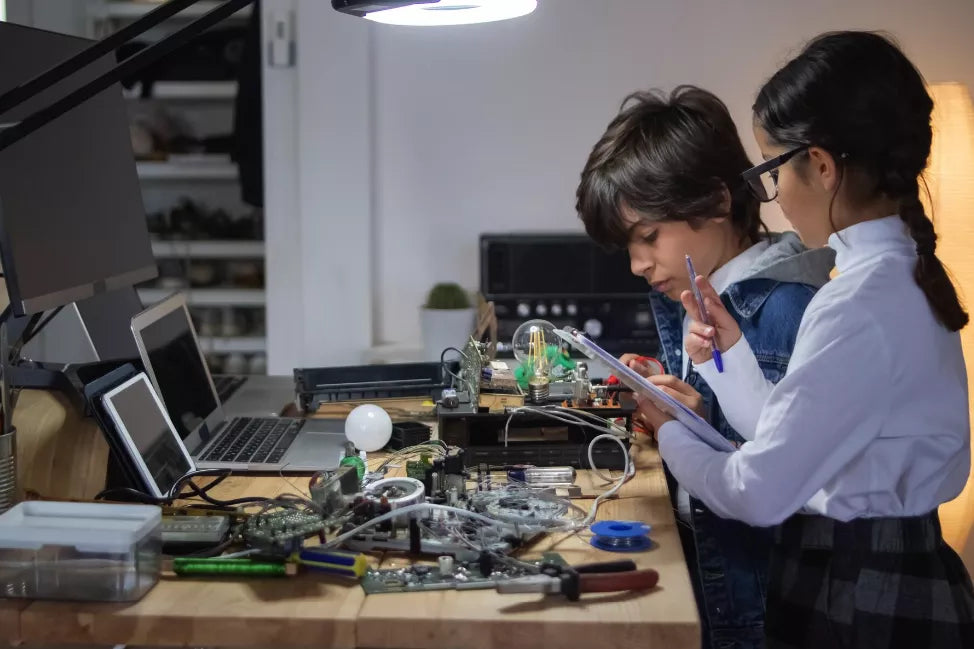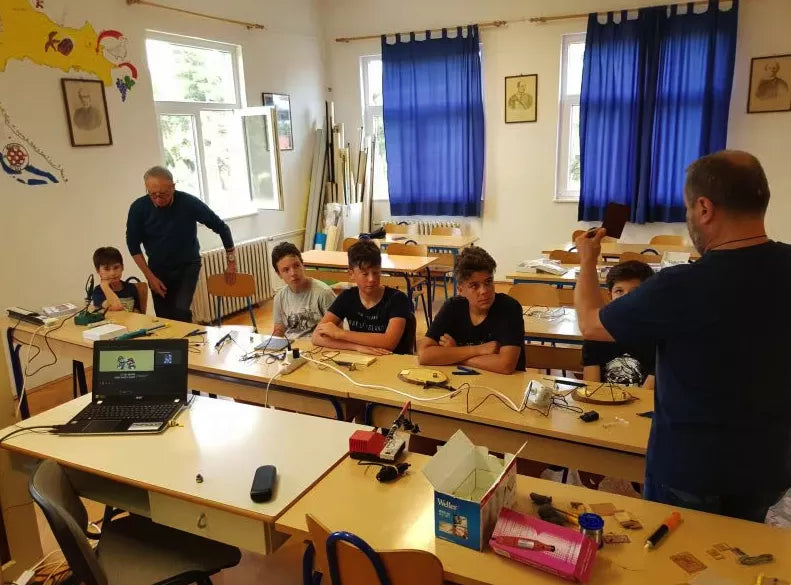
How To Choose a DIY STEM Kit for Your School Classroom?
Read stories how our founder Albert turned his childhood passion into CircuitMess, and get exciting DIY project ideas you can do with your kids at home for free.
Table of content
By this point, the buzz around DIY STEM materials in educational spaces has likely reached your ears, especially the talk about specialized kits that help students learn science while having fun.
They may seem too good to be true, or may even look like just another educational fad. However, these kits come with tangible benefits.
Join us as we discuss what these benefits are, how to select the perfect DIY STEM kit, along with STEM activities for your classroom, and how to effectively integrate them into your existing curriculum. Let's dive in!
What are the benefits of using STEM kits in the classroom?
You're likely already familiar with some of the frequently discussed benefits of STEM toys and projects, such as boosting fine motor skills, improving problem-solving skills, or discovering a passion for science, technology, engineering, and mathematics.
That's why we'll focus on something different; how these kits enhance the retention of complex concepts and spark creativity in students.
Benefit #1: Better retention of concepts
As we've mentioned when talking about the best science kits, the University of Chicago found that physical experiences enhance STEM learning.
Hands-on experiments can help students internalize complex concepts more effectively, which leads to deeper understanding. Better test scores are just an added bonus!
Whether you decide to enrich your classroom with science kits, pieces of modern technology, or real-world engineering tools and supplies, you'll provide an immersive learning environment where the knowledge stays with the student for good.
Benefit #2: Fostering creativity
The beauty of STEM kits lies in their ability to turn conventional classroom practices around. Learning doesn't have to revolve around dry lectures—the kits let students roll up their sleeves and dive into science and engineering experiments, transforming them from passive recipients of information into active creators.
This way of hands-on learning encourages students to engage differently, practice problem solving, develop design thinking, and invent their own solutions to STEM challenges ahead.

By encouraging your students to embrace creativity in their learning journey, you're also making STEM subjects more approachable and enjoyable.
Not everyone likes textbook-based lessons, but most kids enjoy experimenting with STEM kits. So, a creative outlet for learning may very well be the key to unlocking a student's full potential, and all of that is possible by taking on an innovative approach to STEM teaching.
How to choose the right STEM kit for your classroom
Are you on board yet?
If you are, you may be getting ready to select the right kit for your students. Besides some obvious criteria, such as topics and price, we'll list three other crucial factors to consider before committing to a seller.
Customizing STEM kits for different educational levels
First, remember that educational kits are not one size fits all. That's the reason why it's important to tailor your selection to the educational level and ages of your students.
For instance, our own kit lines are divided into two categories: our simpler kits are suitable for kids aged nine and beyond, while more complex projects are designed for learners ages eleven and above.

Your choice should be age-appropriate, meaning that it's challenging enough to stimulate curiosity and learning, yet not so complex that it becomes frustrating.
Innovative STEM classroom activities using DIY kits
When you hear the phrase STEM experiments for primary school, your mind likely springs to classic activities like creating DIY catapults or baking soda/vinegar volcanoes.
Since you're already investing in new materials for your students, you may as well ensure that they fill your classes with innovation and imagination. In other words, you need kits that allow students to approach STEM topics in new ways, and complete projects that they haven't seen before.
This approach will keep your lessons, fresh, fun, and engaging. No more lemon batteries, please! Just kidding—we love ourselves a classic, but you get the point.
Project-based learning with STEM kits
As defined by the Buck Institute for Education, project-based learning (PBL) is
"a teaching method in which students learn by actively engaging in real-world and personally meaningful projects."
What does that mean for you when choosing your kit seller?
Well, there are many kits out there that offer cool STEM experiments, but they don't necessarily connect with real life and the skills that students would actually use.
It's essential to choose kits that go beyond just being cool and focus on projects with practical applications. Look for those that allow students to build and explore technology they can interact with daily, like smart devices or electronic gadgets.

By choosing PBL-friendly kits, you'll ensure that the STEM activities you assign are not only hands-on and fun, but that they also help kids see the practical side of their learning, making connections between their projects and everyday life. The themes you work on in class should also matter in the real world, too.
How to integrate STEM kits into your existing curriculum
Of course, teachers don't want the new materials disrupting their carefully planned curriculum.
The key is to seamlessly weave these kits into the existing lesson plans in a way that complements the core subjects, enriching the teaching process without overtaking it.
However, the situation is not as straightforward as just sprinkling kit-related activities every few lessons. You'll also have to overcome certain challenges, and measure whether the projects are effective in helping students learn. Let's see how.
Overcoming challenges in STEM kit integration
To keep it simple, let's break down the integration process into a checklist of the top three common problems and their solutions.
- Challenge: Budget limitationsSolution:Explore cost-effective kits, apply for educational grants, or partner with local businesses for sponsorships.
- Challenge: Curriculum alignmentSolution:Identify key areas in your curriculum where STEM kits can naturally enhance learning, and integrate them into those segments. You don't need a kit for each and every lesson!
- Challenge: Lack of support and resourcesSolution:Select a kit provider that offers multiple kinds of educational resources, clear instructions, tools, and responsive customer service.
Assessing the impact of STEM kits on learning
Once you've successfully integrated STEM kits into your curriculum, the next crucial step is to assess their impact on student learning. Are these kits truly enriching the educational experience? Do they make STEM concepts more understandable?
To help you evaluate this effectively, here's another checklist focusing on key areas of assessment and actionable solutions.
- Measuring student engagement:Use surveys, discussions, and observation to check on your students' interest and participation levels during kit-based activities.
- Tracking academic performance:Sure, having fun is important in class. But you should also compare test scores and project results before and after integrating STEM kits to identify any significant changes in academic achievement.
- Evaluating knowledge retention:Conduct periodic quizzes or assessments specifically on topics covered through kit-based activities, even a few months after the initial lessons. This will help you determine if the students are able to recall and apply the concepts they learned long-term.
Real-world examples and success stories
STEM educators are often naturally prone to taking things with a grain of salt, critically looking for empirical evidence before fully embracing new teaching strategies.
There are many success stories about integrating STEM kits into classrooms, and we'll now see two particularly inspiring examples so that you can see how exactly kits complement traditional teaching.
First, let's go back to the pandemic times, when teachers quickly had to adjust to remote classes.
Science education professor Michael McCoy of the University of Regina used the transition as an opportunity to try out STEM kits and bridge the gap between hands-on classroom experiences and at-home education.

The students were happy with the approach, and they even looked forward to science classes, knowing that each lesson would let them experiment, discover new findings, and put theory into practice.
Our next story goes to show that STEM kits are also beneficial beyond traditional class structures, as seen in a workshop hosted by Zoran Černja of the Kanfanar Innovators Association.

Here, STEM kits were not just accessories or supplementary materials—they were the core around which the entire workshop was structured.
Both the instructors and the primary school students loved the experience, in which students learned about electric components, soldering, and printed circuit boards.
As you can see, these kits can be resources for hands-on learning regardless of the structure of classes you're teaching, and they lend themselves to a variety of scenarios.
Additional resources you should further explore
We know that as an educator, you're always on the lookout for more information and ideas. We've got you; here's a list of additional resources you can browse and find more about the benefits of these innovative STEM materials.
- Science kits for elementary and middle school classrooms
- Trends in robotics-based STEM education
- STEM teaching strategies for your classroom
- Bringing STEM kits home
- Practical work in science education
Revolutionize your STEM lessons with CircuitMess STEM kits
And just like that, you're equipped with the knowledge to integrate STEM kits into your classroom. Depending on the subject area you teach, your next step is to look for the kit provider that best aligns with your curriculum.
If your teaching focus is on areas like robotics, computer science, physics, math, or engineering, CircuitMess could be the perfect fit for your needs. Our Educators program is packed with a variety of perks, such as special discounts for STEM kits, a supply of spare parts, a collection of workshop materials, and more.
These perks are designed to make integrating STEM kits into your lessons easier and more effective, enriching both your teaching experience and your students' learning journey.
So, why not take the opportunity to discover what CircuitMess has to offer? Get ready to find electronics kits that provide everything needed to build and complete exciting, educational projects.
Read stories how our founder Albert turned his childhood passion into CircuitMess, and get exciting DIY project ideas you can do with your kids at home for free.
Read more

What is STEM? A Fun and Future-Focused Way to Learn
The future demands adaptable and innovative minds. This guide breaks d...

Is Your Child Ready to Become a Space Explorer? (Here's How)
Your portal to space exploration. Build robots, code games, and unlock...

DIY Delights: 5 Easy Electronics Projects for Kids
Join thousands of parents inspiring their kids with these 5 easy elect...
